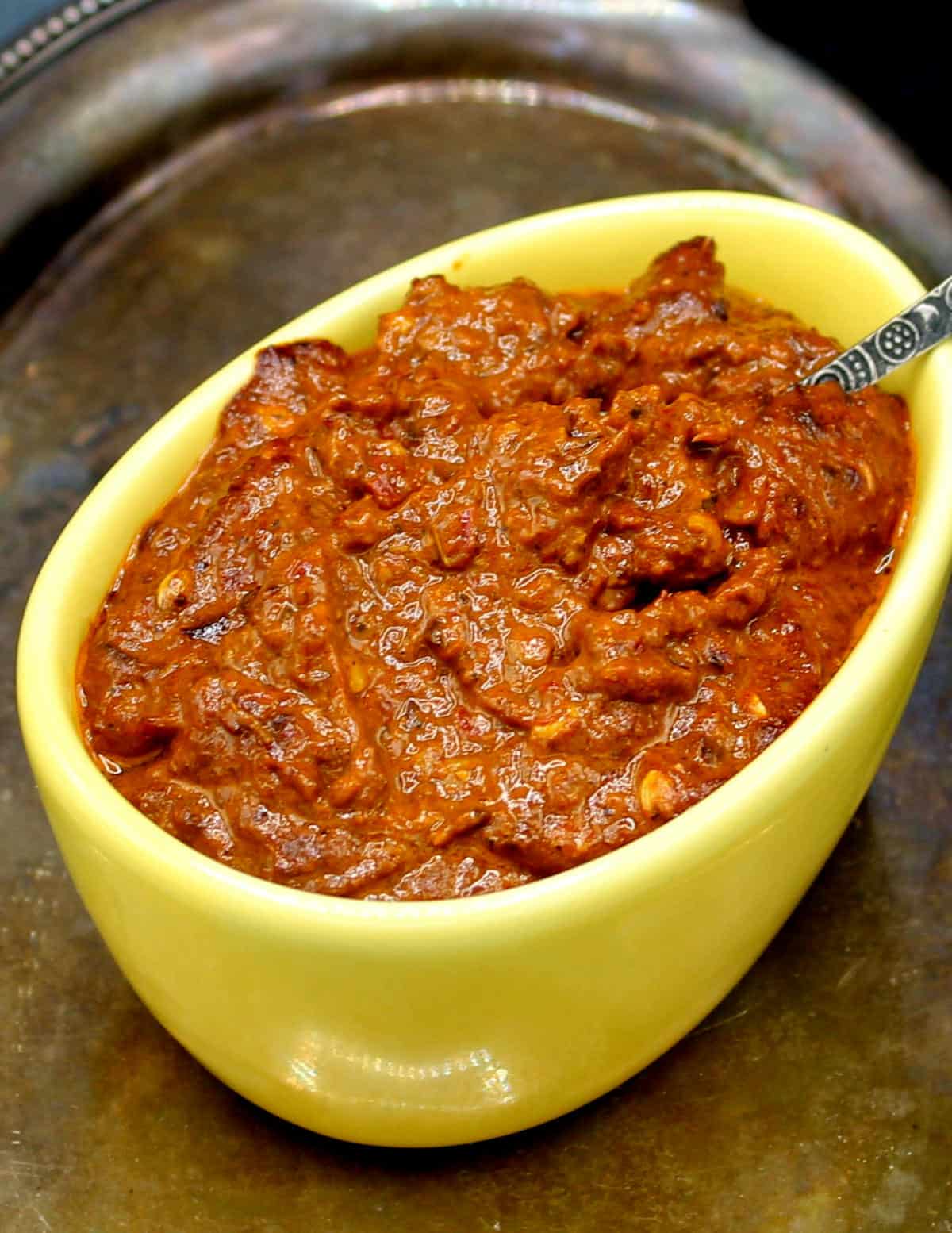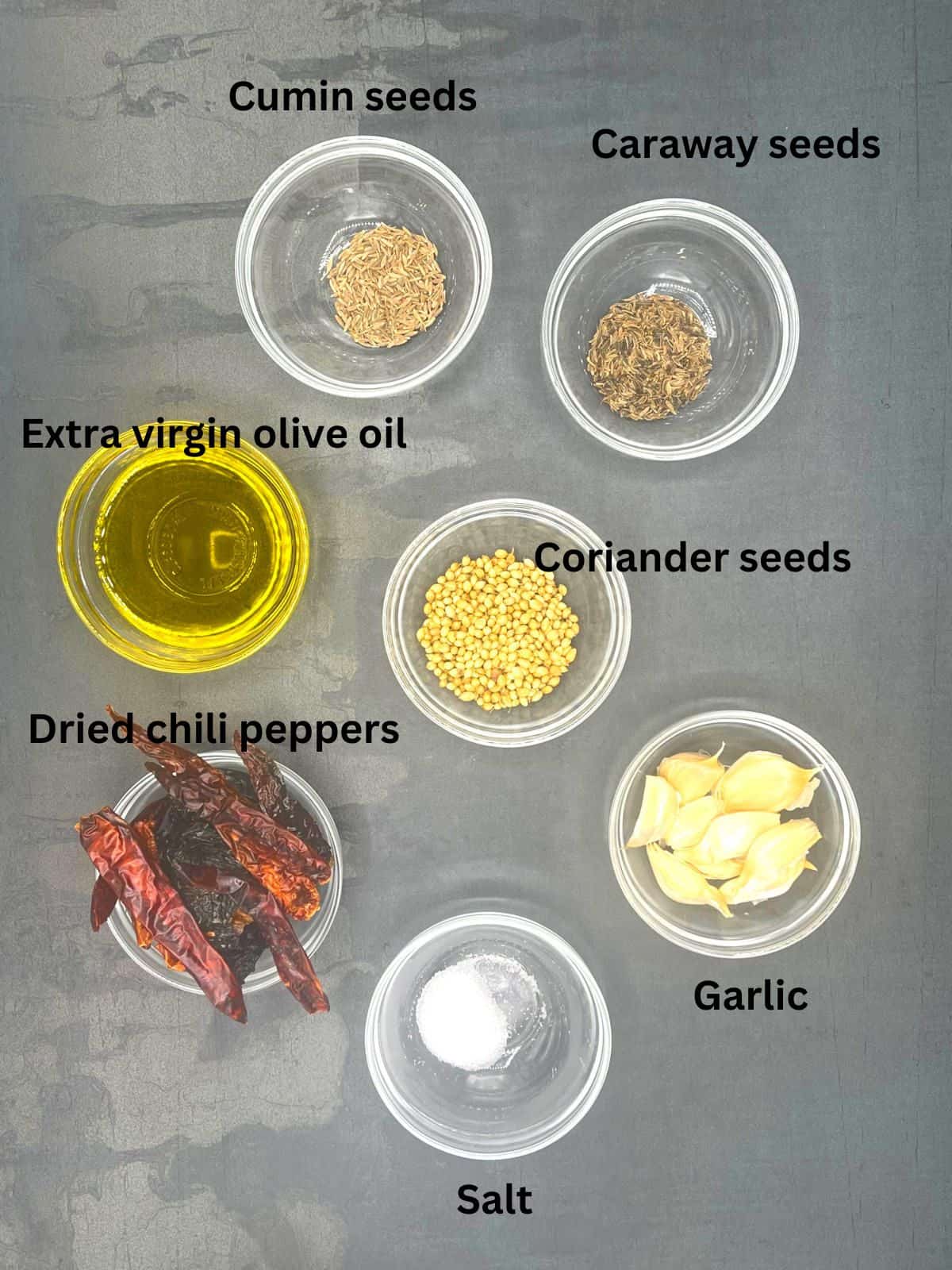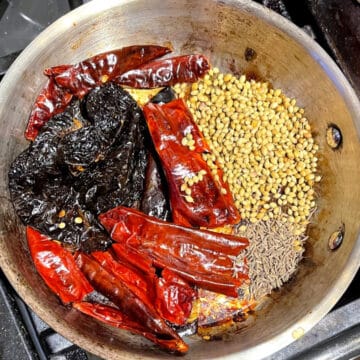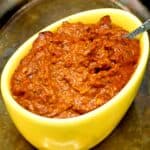Harissa is an aromatic and fiery red sauce or paste that adds a dash of delicious spice to north African recipes like Tunisian pasta and Moroccan chickpea stew. My easy harissa recipe is foolproof and takes no more than 10 minutes of hands-on time to make!

What is harissa?
Harissa is a North African sauce made of dried red chili peppers, garlic, coriander seeds, cumin seeds and caraway seeds. It is believed to have originated in Tunisia although it's now deeply embedded in the cuisine of other North African countries, including Algeria, Morocco and Libya, and Middle Eastern countries, including Israel and Armenia.
The word "harissa" is derived from the Arabic word "harasa," which means “to crush or pound" -- a reference to how the paste is made.
Harissa is an appetizing rich red color, thanks to the large number of chili peppers that go into it. It's also smoky with chilies, cumin, coriander and caraway.
There are many variations of harissa, and some include tomato paste and/or paprika. In our minimalist but extremely flavorful version we can skip those with no loss in flavor.
Why you will love this recipe
- It's loaded with flavor. Harissa is a transformative ingredient. It completely changes the flavor profile of the dish you add it to, with so many complex and delicious notes. Try this recipe once and you'll never want to be without a jar of harissa again!
- It takes just minutes to make. You need to soak the chili peppers for around 15 minutes and then roast them lightly with the other spices. After that all you do is push the button on your blender. No chopping and prepping and no more than 10 minutes of hands-on time needed.
- It is versatile. Although north African in origin, harissa is a versatile sauce and one that can be used to add a flavor wallop to nearly any of your favorite stews, soups, pastas or rice dishes.
- It's everyone friendly. Vegan? Gluten-free? Low-Carb? Soy-Free? No worries! Everyone can eat harissa and enjoy it.
Ingredients and substitutions

- Chili peppers. I use a mix of hot and sweet Mexican chili peppers in my harissa paste, because they add tons of flavor. My favorite combination is one mild but gigantic ancho pepper, which adds great color, two moderately hot guajillo peppers for smokiness, and six to eight arbol chili peppers for heat. You can deseed the peppers for less heat.
- Coriander seeds. These add a fruity, lemony aroma to the harissa.
- Caraway seeds. Caraway seeds add a sharp, nutty, bittersweet flavor with a hint of lemon. You can skip them if you don't have them and add more cumin instead.
- Cumin seeds. Cumin adds an earthy and warm aroma.
- Extra virgin olive oil. This is for blending the harissa and it also rounds out the flavors of the spices nicely. If you want to use less oil, reduce to two tablespoons and add more of the chili pepper soaking liquid while blending.
- Garlic. With its spicy, pungent, addictive flavor notes, garlic is a traditional and essential ingredient in harissa.
- Lemon (optional). Lemon adds a nice finish to the harissa, but you can skip it if you don't want to use because there's already a lot of citrusy flavor here from the spices. You can also use a tablespoon of vinegar instead of lemon.
- Salt to taste.
Step by step instructions

Soak the peppers: Soak the chili peppers in enough hot water to cover the peppers for 15 minutes. Drain, but store the soaking water. Pat the peppers dry with paper towels.

Toast the peppers and spices: Place the peppers on a skillet along with the coriander seeds, cumin seeds, caraway and garlic. Toast the chili peppers and spices until aromatic, about five minutes over medium low heat.

Place in blender: Transfer all ingredients to the blender or food processor and add olive oil and salt to taste. Add the lemon juice, if using.

Blend: Blend the harissa ingredients into a coarse paste. If necessary add the reserved chili soaking water, a tablespoon at a time, until you get the consistency you want.

More uses for harissa
- Stir in some harissa to add vibrant flavor to an African Peanut Stew. Or make Vegan Harissa Meatballs for the ultimate appetizer!
- Use it to spice up a delicious tagine, like this vegan Jackfruit "Lamb" Tagine. Add harissa to the tagine instead of the ras el hanout spice mix.
- Use it as a dressing for this Moroccan Couscous Salad along with a dash of lemon.
- Use it to flavor a Moroccan Lentil Stew with veggies and mint. Or add it to this Roasted Eggplant Soup instead of za'atar.
Recipe FAQs
Harissa is meant to be spicy and should taste quite spicy when tasted on its own. But the heat is diluted once you add it to a recipe. If you are very sensitive to heat you can reduce the quantity of spicy peppers (chile de arbol) and increase the number of milder chili peppers like guajillo and ancho peppers in the recipe.
Harissa has a fruity, smoky and spicy flavor profile and it is also delightfully garlicky. This sauce has layers of complex flavor despite the simple ingredient list.
In Tunisia harissa would be made with local peppers, such as baklouti peppers, but since those are not easy to find in other parts of the world you can use nearly any type of dried chiles that are available to you. I use a combination of Mexican chili peppers. If you are in India, for example, use a combination of mild and brightly colored chili peppers, like Kashmiri peppers, and spicy peppers, like Indian red chillies. Some recipes for harissa include roasted red peppers. If you'd like to add a roasted red pepper to your harissa, use it instead of the ancho pepper and add it directly to the blender.
Harissa is often added at the end of cooking to stews and soups. But you can add it earlier in slow-cooked recipes like tagines to let the flavors develop further and meld with the other ingredients.
Storage instructions
- Refrigerate: Harissa can be refrigerated for up to two weeks.
- Freeze: Freeze the harissa in an airtight, freezer-safe container for up to three months. Thaw before using.

Did you make this recipe? Leave a review and a star rating, or tag us on Instagram! Thanks!

Homemade Harissa Recipe
Equipment
-
Small bowl
-
Blender or food processor. You can also use a mortar and pestle to crush the spices.
Ingredients
- 1 ancho pepper
- 2 guajillo peppers
- 7 arbol peppers
- 1 tablespoon coriander seeds
- 1 teaspoon cumin seeds
- 1 teaspoon caraway seeds
- ¼ cup extra virgin olive oil
- 8 cloves garlic
- 2 tablespoon lemon juice (optional)
- Salt to taste
Instructions
-
Soak the peppers: Soak the chili peppers in enough hot water to cover the peppers for 15 minutes. Drain, but store the soaking water. Pat the peppers dry with paper towels.
-
Toast the peppers and spices: Place the peppers on a skillet along with the coriander seeds, cumin seeds, caraway and garlic. Toast the chili peppers and spices until aromatic, about five minutes over medium low heat.
-
Blend the harissa: Transfer all ingredients to the blender or food processor and add olive oil and salt to taste. Add the lemon juice, if using. Blend. If necessary add the reserved chili soaking water, a tablespoon at a time, until you have a coarse paste.
-
Store the harissa in an airtight jar in the fridge or freezer.
Notes
- In Tunisia harissa would be made with local peppers, such as baklouti peppers, but since those are not easy to find in other parts of the world you can use nearly any type of chili pepper that is available to you. I use a combination of Mexican chili peppers. If you are in India, for example, use a combination of mild and brightly colored chili peppers, like Kashmiri peppers, and spicy peppers, like Indian red chillies.
- Refrigerate: Harissa can be refrigerated for up to two weeks.
- Freeze: Freeze the harissa in an airtight, freezer-safe container for up to three months. Thaw before using.
Nutrition
The post Homemade Harissa appeared first on Holy Cow Vegan.
The post Homemade Harissa appeared first on Holy Cow Vegan.

0 Comments